One of the most common complaints we hear of is shoulder pain. Since so many different structures make up the shoulder, it is vulnerable to a host of different problems.
Shoulder Anatomy
- The shoulder is made up of 3 bones
- Humerus (Upper Arm Bone), Scapula (Shoulder Blade) and Clavicle (Collarbone)
- Your arm is held in the shoulder socket by your rotator cuff muscles
- There are muscles and tendons that cover your Humerus and attach it to the Scapula
- The bursa (lubricating sac) is between the rotator cuff and the acromion (bone on the top of the shoulder) and allows the rotator cuff tendons to glide when you move your arm
Who is at risk?
- Young athletes
- Particularly those who use their arms overhead for swimming, baseball and tennis
- Adults in the Middle Age
- Particularly those who perform repetitive lifting or overhead activities such as construction workers, painters, car mechanics
What is the pain a result of?
- “Tendinitis”: rotator cuff tendons are irritated or damaged
- “Bursitis”: Bursa is inflamed and swollen with fluid
- “Impingement”: The acromion is rubbing against/impinging on the tendon and the bursa causing irritation, therefore, the tendon gets/feels stuck
Symptoms
- Initially, symptoms may be mild
- Sudden pain when lifting and reaching
- Pain radiating from the front of the shoulder to the side of the arm
- Symptoms can develop into
- Swelling and tenderness in the front of the shoulder
- Pain and stiffness when lifting the arm
- Pain when lowering the arm from an elevated position
- If not treated right away, symptoms can increase and progressively get worse leading to:
- Loss of strength and motion
- Difficulty doing activities that place your arm behind your back
Treatment
- Rest
- Rest the shoulder
- Avoid overhead activities
- Non-Steroid Anti-inflammatory Drugs (NSAID’s) such as Ibuprofen can help to reduce pain and swelling
- Physiotherapy
- Chiropractic Treatments
- Registered Massage Therapy
What is Frozen Shoulder?
Frozen Shoulder, also known as adhesive capsulitis, is an inflammatory condition that affects the capsular tissue of the shoulder. It occurs when the capsule that holds the joint together thickens and restricts movement. Frozen shoulder is characterized by pain and stiffness that develops gradually and can last from months to years. No one knows why this occurs but experts believe previous shoulder injuries, surgeries, strokes, and some chronic illnesses can increase your risk of developing frozen shoulder.
Symptoms:
Frozen shoulder develops in 3 stages: Each stage can last up to a few months.
1. Freezing stage – shoulder pain with movement.
2. Frozen stage – pain decreases but your range of motion becomes more restricted especially with relation to the big three:
- Reaching overhead,
- Reaching out to the sides,
- Reaching behind the back.
3. Thawing stage – range of motion improves
Treatment:
Treatment involves pain reduction and preserving range of motion.
- See the shoulder exercise listed above for helpful stretches you can do at home.
- Non-steroid Anti-inflammatory Drugs ( Advil, Aspirin, Aleve..)
As always, the best treatment is prevention in the first place. If you’ve had a previous shoulder injury, or shoulder surgery come see our experts on helpful tips to help prevent development of frozen shoulder.
Exercises for Shoulder Injuries
Your shoulder allows for a great range of motion in your arm and shoulder injuries can significantly impair your function and ability to perform daily activities. Our team recommends the following exercises for those with shoulder injuries.
Pendulum Exercise
Perform this exercise first:
- Relax your shoulder
- Stand and lean slightly forward allowing your injured arm to hang down
- Swing your injured arm in a small circle. The circle should be around a foot in diameter.
- Perform 10 revolutions in one direction
- Switch directions
- Perform twice a day
Once your symptoms improve, increase the diameter of the swing, but don’t force it! When you find this is easy and you’re ready for more, increase the stretch by holding a 3-5lb weight in the swinging arm!
Wall Walk Exercise
- Face a wall three-quarters of an arm’s length away.
- Reach out and touch the wall at waist level with your fingertips of your injured arm.
- Slowly walk your fingers up the wall. Make sure your elbow is slightly bent. Walk your fingers until you’ve raised your arm to should level or as far you feel comfortable.
- Slowly lower your arm and repeat.
- Perform 10-20 times a day.
Once your symptoms improve, walk your fingers further up the wall, beyond or above shoulder level.
Want more exercises? There are multiple muscles that attach to the shoulder complex. If you are experiencing any of the symptoms mentioned above, call Backs in Action Rehab & Wellness Centre and book an assessment with one of our experienced practitioners. At Backs in Action we are happy to help reduce your pain and get you back into your activities in no time!




